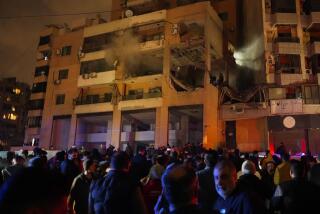Strategist’s Loss Could Cripple Ability to Launch New Assaults
- Share via
WASHINGTON — The apparent death of Mohammed Atef, Osama bin Laden’s top military commander, and the routing of Al Qaeda’s top command have struck a near-crippling blow to the terrorist network’s ability to initiate coordinated, new attacks, authorities and counter-terrorism experts said Friday.
Atef’s death, though unconfirmed, could destroy the Al Qaeda network’s ability to launch counterattacks against U.S. forces now coursing through Afghanistan in pursuit of the terrorist organization. Atef and other Al Qaeda members were said to be plotting just such a response when a U.S. airstrike near Kabul, the Afghan capital, hit the building in which they were meeting sometime in the last few days, said a Bush administration official with extensive knowledge of the terrorist organization.
But the loss of Atef, along with the flight of other Bin Laden lieutenants such as Ayman Zawahiri and Abu Zubeida, is also a significant long-term setback for the terrorist organization--and potentially a mortal one, according to law enforcement and intelligence officials.
In the absence of their leaders, Al Qaeda cells around the world will still be able to strike, officials said, adding that some attacks may already have been planned.
But without Atef--Al Qaeda’s operational mastermind--and other Bin Laden lieutenants in place in a “command and control” center, the far-flung groups will have much more difficulty launching sophisticated new operations, the officials said.
“In and of itself, it is a very important loss for them,” the Bush administration official said.
Like many terrorism experts, the official likened Al Qaeda to a tightly run corporation, with myriad global outposts. The cells operate with some autonomy but are held together by a nerve center that issues directives, coordinates communications and pays the bills.
With much of that infrastructure gone, and top leaders presumed dead or in hiding, the outposts in Europe, Asia, Africa and North and South America have essentially been cast adrift.
“Bin Laden had clearly put into place a continuity-of-operations plan. What he didn’t count on was that his entire sanctuary would be blown up,” the official said. “There was a line of succession. But if you eliminate all the members of that chain of succession, it doesn’t leave much in the way of a succeeding authority.
“There is still an organization in place,” the official added, “but it does not have leadership.”
Atef’s death could not be confirmed in part because the building was destroyed, the administration official said. “If there is a body, it’s in little pieces.”
Atef’s apparent death is significant not just because of his role as the war chief of Bin Laden’s terrorist empire. He was also considered by many to be Bin Laden’s second in command, and one of two heirs apparent--along with Zawahiri, Al Qaeda’s spiritual leader. Atef’s daughter was married to Bin Laden’s son this year in a videotaped ceremony showing the two men sharing a prayer rug and smiling.
Little is known about the mysterious Atef, who has also gone by the names Abu Hafs, Abu Hafs al Masri, Taysir and Abu Khadijah. At 6 feet, 4 inches to 6 feet, 6 inches, he towered over most other Al Qaeda members, as does Bin Laden.
It is not known precisely how or where the two met. U.S. authorities say they don’t even know when or where Atef was born, except that it was in Egypt.
For years, Atef worked at the right hand of Bin Laden, and he is believed to have coordinated several of Al Qaeda’s most audacious and deadly terrorist attacks. Besides his suspected role in Sept. 11 attacks, Atef was indicted for his alleged involvement in the Aug. 7, 1998, U.S. Embassy bombings in Kenya and Tanzania, in which 224 people were killed. Last month, President Bush put him on a list of 22 most-wanted terrorists, describing him as Bin Laden’s official second in command.
The State Department has a $5-million bounty on Atef’s head for “the murder of U.S. nationals outside the United States.”
Atef was a member of the Islamic Jihad of Egypt and supported the decision of Zawahiri, the group’s leader, to merge with Al Qaeda in 1998 into an umbrella terrorist organization known as the International Front for Fighting Jews and Crusaders. Atef was sentenced in absentia to life in prison in Egypt on charges of subversion and membership in Islamic Jihad.
Atef, who is believed to be a former police officer, left Egypt in the early 1980s and joined up with Bin Laden in Afghanistan. Together, they helped to recruit fighters for the war against the Soviet occupation. He was a founding member of Al Qaeda, at first in charge of its security and later head of operational planning and terrorist training.
According to the British government, Atef was in Somalia in 1992 and 1993, organizing Somalis to commit violence against U.S. and U.N. troops stationed there. He would report back to Bin Laden, who was then running Al Qaeda from a farmhouse near Khartoum, the Sudanese capital.
He allegedly helped to orchestrate the East African embassy bombings. In the days before those attacks, Atef kept in touch by satellite phone with the conspirators preparing to set off the bombs, according to evidence presented during the trial of the embassy bombers in New York.
The embassy indictment also said that Atef had encouraged attacks on U.S. troops in Somalia in October 1993, as a result of which 18 U.S. Rangers were killed while hunting for Somali warlord Mohammed Farah Aidid and trying to apprehend some of his aides.
With leaders such as Atef gone or on the run, Al Qaeda cells are expected to try to reach out to one another, plan future attacks, share information and raise the money that is the lifeblood of such a terrorist network. Some lower-ranking members of Al Qaeda cells will step up and try to replace Atef and the other leaders, counter-terrorism officials said Friday.
More to Read
Sign up for Essential California
The most important California stories and recommendations in your inbox every morning.
You may occasionally receive promotional content from the Los Angeles Times.










